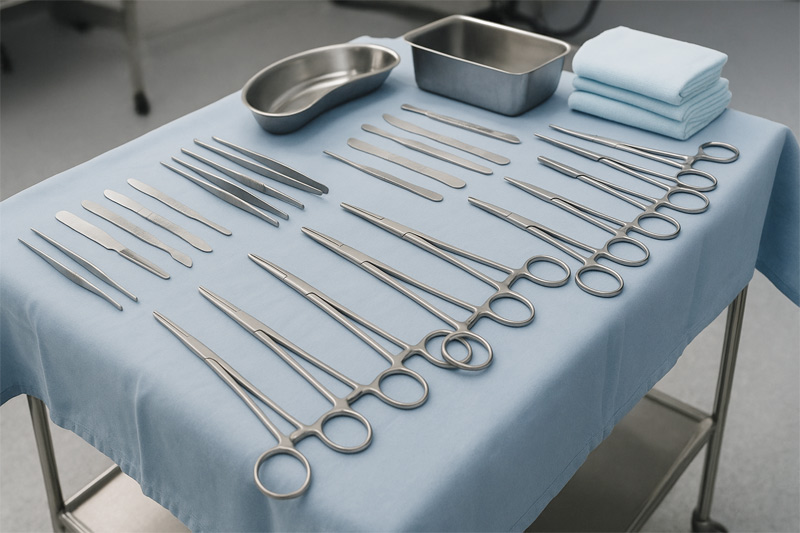

In modern operating rooms, the surgical instrument table plays a critical role in maintaining workflow efficiency, sterility, and patient safety. Often overlooked in comparison to high-tech surgical equipment, this simple yet indispensable table ensures that surgical tools are well-organized, readily accessible, and free from contamination. This article explores the key features, types, materials, and best practices associated with surgical instrument tables, guiding healthcare professionals and procurement teams.
What Is a Surgical Instrument Table?
Depending on its design and function, a surgical instrument table, also known as a Mayo stand or back table, is a specially designed table used to hold sterile surgical instruments and supplies during an operation. It ensures that tools are positioned within reach of the surgical team, allowing for smooth procedural flow without compromising the sterile field.

Common Types of Surgical Instrument Tables
1. Mayo Stand
A Mayo stand is a small, movable instrument table typically placed over the surgical field. It allows immediate access to frequently used instruments and can be easily repositioned during surgery.
Features:
● Height-adjustable
● Stainless steel tray
● Mounted on wheels or a pedestal base
● Compact and mobile
2. Surgical Back Table
A surgical back table (also known as a scrub table) is larger and usually located behind or beside the surgeon. It holds the majority of instruments, supplies, and sometimes implants.
Features:
● Larger surface area
● Used for initial instrument setup
● Often covered with a sterile drape
● Designed for maximum organization and capacity
Key Materials and Design Considerations
Surgical instrument tables are typically made from high-grade stainless steel (304 or 316) to ensure durability, hygiene, and ease of sterilization. Some modern versions include antimicrobial coatings or are constructed with polymer-based laminates for lightweight mobility.
Important design features:
● Corrosion resistance: Crucial for repeated cleaning and disinfection.
● Non-porous surfaces: Prevent bacterial growth.
● Rounded edges: Reduce injury risk and make cleaning easier.
● Locking casters: Enhance mobility while preventing accidental movement during surgery.
● Adjustability: Allows ergonomic customization for various procedures.
Best Practices for Using Surgical Instrument Tables
Implementing the following best practices ensures optimal performance and safety in the operating room:
1. Sterile Setup Protocol
● Use sterile drapes to cover the table.
● Instruments should be arranged in order of use.
● Maintain sterile technique throughout the procedure.
2. Instrument Organization
● Group instruments by type (cutting, grasping, retracting).
● Position frequently used tools closer to the operating site.
● Use instrument trays to prevent shifting
3. Regular Cleaning and Maintenance
● Tables should be disinfected before and after every procedure.
● Inspect for signs of wear or corrosion regularly.
● Avoid harsh chemicals that may degrade the surface.
Benefits of High-Quality Surgical Instrument Tables
Investing in ergonomic, durable, and customizable surgical instrument tables enhances:
● Workflow efficiency: Minimizes delays and improves response time.
● Infection control: Reduces cross-contamination risks.
● Staff safety: Decreases the chance of sharps injuries and repetitive strain.
● Longevity: High-quality materials offer long-term cost savings.
Choosing the Right Table for Your OR
When selecting a surgical instrument table, consider:
● Type of surgeries performed
● Space constraints in the operating room
● Need for mobility or fixed placement
● Compliance with hospital infection control protocols
Many manufacturers offer customizable models with add-ons like modular trays, electrical outlets, and integrated lighting for specialized applications.
Conclusion
A well-designed surgical instrument table is more than just a surface—it's a vital component of every successful surgery. Its role should never be underestimated, from enhancing instrument access and sterility to improving staff ergonomics and procedural flow. Whether outfitting a new operating room or upgrading outdated equipment, investing in high-quality surgical instrument tables pays dividends in safety, efficiency, and patient outcomes.
References
1. Association of periOperative Registered Nurses (AORN). Guidelines for Perioperative Practice. AORN, 2024.
2. World Health Organization. Surgical Site Infection Prevention Guidelines, 2018.
3. American National Standards Institute (ANSI). Healthcare Facility Guidelines for Furniture and Fixtures, ANSI/AAMI HE75, 2020.
4 . Bellamy, R. F. (2022). Operating Room Design: Principles and Practices. Surgical Technology International.
5. Joint Commission International. Standards for Hospital Accreditation, 8th ed., 2023.